![]() July
July
This month's features in our summer
issue :
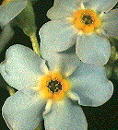
The author of these walks regularly suggests that readers carry a 10X hand lens on a walk to admire nature in close-up...... particularly at this time of year, when the countryside is full of flowers in bloom and insects to study.
This month, none of the subjects studied in close-up require a microscope at all, just that 10X hand lens ...... and if you have a camcorder or still camera with a rarely used 5-10X macro capability why not take it with you on a walk and take some close-ups! Two articles in 'Further Reading' provide more information on buying and using a hand lens.
Please read the important notes on collecting.
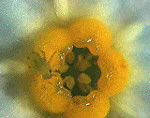 Everyone admires flowers, whether in the garden, ornamental park
or in the wild. The beauty of the larger flowers such as roses
and tulips can be appreciated without any magnification aid. But
those smaller flowers that are barely 5-10mm across often have
wonderful shapes, colours and textures that can be overlooked
unless you look closely with a lens.
Everyone admires flowers, whether in the garden, ornamental park
or in the wild. The beauty of the larger flowers such as roses
and tulips can be appreciated without any magnification aid. But
those smaller flowers that are barely 5-10mm across often have
wonderful shapes, colours and textures that can be overlooked
unless you look closely with a lens.
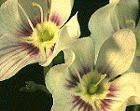 Another
small flower that is attractive in close-up is the Speedwell (Veronica).
There are a number of wild species with delicate blue flowers,
but the garden varieties such as the one right from the author's
garden are also worth studying. Note that whereas the anthers of
the forgetmenot are almost enclosed within a tube formed by the
fused petals, the speedwell's anthers are not enclosed. (The
anthers are the pollen- bearing structures on the stamen, the
stalk which carries them).
Another
small flower that is attractive in close-up is the Speedwell (Veronica).
There are a number of wild species with delicate blue flowers,
but the garden varieties such as the one right from the author's
garden are also worth studying. Note that whereas the anthers of
the forgetmenot are almost enclosed within a tube formed by the
fused petals, the speedwell's anthers are not enclosed. (The
anthers are the pollen- bearing structures on the stamen, the
stalk which carries them).
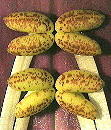
 Many larger flowers also have
easily overlooked detail in their flower structure. The Foxglove
(Digitalis) for example, which is in flower in the
author's area at the moment, is a tall plant with spikes of
pink-purple bell-shaped flowers 4-5cm long. If a flower is split
open, the patterning on the inside of the flower (right) and the
detail on the unopened anthers which carry the pollen can be seen
(left).
Many larger flowers also have
easily overlooked detail in their flower structure. The Foxglove
(Digitalis) for example, which is in flower in the
author's area at the moment, is a tall plant with spikes of
pink-purple bell-shaped flowers 4-5cm long. If a flower is split
open, the patterning on the inside of the flower (right) and the
detail on the unopened anthers which carry the pollen can be seen
(left).
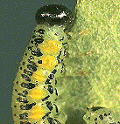 At this time of
year the larvae of butterflies and moths can be seen on their
respective food plants. The larvae are often attractive and worth
studying in close-up. Hundreds of the larvae (caterpillar) shown
left were eating their way through the leaves of the dwarf willow
(Salix sp) in the author's garden. Only the midribs of
the leaves were left by the time they had finished!
At this time of
year the larvae of butterflies and moths can be seen on their
respective food plants. The larvae are often attractive and worth
studying in close-up. Hundreds of the larvae (caterpillar) shown
left were eating their way through the leaves of the dwarf willow
(Salix sp) in the author's garden. Only the midribs of
the leaves were left by the time they had finished!
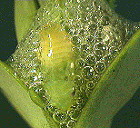 Another common sight
in the author's area at this time of the year is frothy masses on
the stems of plants. You may have noticed them many times
yourself, but have you ever stopped to examine what is inside
this froth? It is produced by the nymph (see Footnote 1) of the
froghopper which is also known as the spittlebug or cuckoo spit.
The nymph can be seen in the froth on the image right. It is
facing downwards, and the yellow abdomen and one of the two
reddish eyespots on the head are visible.
Another common sight
in the author's area at this time of the year is frothy masses on
the stems of plants. You may have noticed them many times
yourself, but have you ever stopped to examine what is inside
this froth? It is produced by the nymph (see Footnote 1) of the
froghopper which is also known as the spittlebug or cuckoo spit.
The nymph can be seen in the froth on the image right. It is
facing downwards, and the yellow abdomen and one of the two
reddish eyespots on the head are visible.
Footnotes on the froghopper section
1) A nymph is a sexually immature form usually similar to the
adult and occurs in a number of insect groups. In contrast, a
larva is also an immature stage before the adult (not just in
insects) but it bears no resemblance to the adult. For example,
the caterpillar is the larva of the butterfly and moth.
2) Froghoppers belong to the insect order Homoptera. This order is considered by some taxonomists a sub-order of the order Hemiptera and a separate order by others. The family to which the froghoppers belong, the Cercopidae, is referred to as the Aphrophoridae in some older textbooks. Confused? .... so is the author!
Read an article 8X Everything in the July issue of Micscape by Maurice Smith. This illustrated article gives advice on what hand lens to buy, what to look at and even how to take video or still pictures through it!
Read an article in the Micscape library on Using your camcorder as a microscope by Maurice Smith. This provides an illustrated introduction on how to use your camcorder for close-up filming.
Flowers
The structure of plants and their flowers should be
covered in an introductory guide to botany or a good illustrated
identification guide to wild flowers of your region.
Encyclopaedias should also give a good introduction to the
structure of flowering plants.
Insects
There are a wide range of books on insects, particularly
the more popular groups like butterflies and moths. A good
example of a general guide is Collins Guide to the
Insects of Britain and Western Europe by M Chinery. ISBN
0 00 219137-7.
Note that general guides of this type only indicate
representative species or those most likely to be found for
groups such as beetles and flies, because of the large number of
species in some insect groups.
The flower images were taken using a CCD camera with a 50mm
SLR camera lens and extension tubes attached and the screen
magnifications are between 5-7X . The close-up of the Myosotis
is magnified 20X and was taken with the CCD camera attached to a
stereo microscope with no eyepiece using a 1X objective.
Camera images were transferred to the PC using a Creative Video
Spigot capture card.
Image manipulation using Photostyler v2.0 software.
The author Dave Walker
is a UK based amateur naturalist keen to encourage people to
explore nature in close-up.